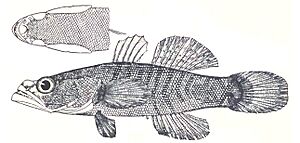Bostrychus expatria facts for kids
Quick facts for kids Bostrychus expatria |
|
|---|---|
 |
|
| Conservation status | |
| Scientific classification | |
| Synonyms | |
|
The Bostrychus expatria is a special type of freshwater fish. It belongs to the Butidae family. This fish is found only in one place in the world: Lake Manguao in the Philippines. This means it is endemic to that lake.
Contents
About This Fish
What it Looks Like
The Bostrychus expatria is a small fish. It can grow up to about 14.4 centimeters (or 5.7 inches) long. Its body shape is typical for fish that live on the bottom of a lake. It's not built for fast swimming.
It has two separate fins on its back, called dorsal fins. The first one has spiny supports. Its tail fin is straight, not very thick. The fish's eyes are on the top of its head. This helps it see things above while resting on the lake bottom.
Where it Lives
This unique fish lives only in Lake Manguao. This lake is in the northern part of Palawan island in the Philippines. Several small streams flow into Lake Manguao. However, no rivers flow out of it.
The Bostrychus expatria shares its home with at least two other fish species. These other fish are also found only in Lake Manguao.
What it Eats and How it Lives
Scientists haven't studied Bostrychus expatria much. This is because its home, Lake Manguao, is quite remote. We do know that it's a benthic species. This means it spends most of its time resting on the lake's bottom.
Even though it's a small fish, B. expatria is a predator. It mostly eats small crustaceans. These tiny creatures live in the muddy bottom of the lake. Sometimes, it also eats other small fish.
Why it Matters to People
The Bostrychus expatria is a small freshwater fish. The island of Palawan has many other fish resources. Because of this, B. expatria is not important for commercial fishing. Local people living around the lake might catch it by accident. They use small cast nets for fishing. The native people call this fish bulokot.
Protecting the Fish
Its Conservation Status
The Bostrychus expatria is in danger. In 1996, it was listed as VULNERABLE. Now, it is considered Critically Endangered (CR). This means it faces a very high risk of disappearing forever.
Since this fish lives only in one lake, its future depends entirely on Lake Manguao. If anything bad happens to the lake, the fish is in big trouble.
Threats to its Survival
The fish population is very sensitive to human activities. Things like pollution can harm the lake. Too much fishing can also reduce the number of fish. Even a small change to the lake's balance could cause this species to go extinct.
The entire island of Palawan is supposed to be a wildlife preserve. This should help protect species like B. expatria. However, wildlife laws are not always followed in the country.
A big problem for the fish is the Tilapia. This fish was put into Lake Manguao in 1992. Tilapia are known for taking over ecosystems. They can eat a lot and disrupt the natural balance. The presence of Tilapia might cause B. expatria to disappear.
Naming the Fish
Its Name History
The name expatria was chosen by Albert William Herre. He picked this name because he thought the fish was like an expatriate. An expatriate is someone who lives outside their home country.
The fish was first named Boroda expatria by Herre. The name Boroda comes from the Visayan word borod. This word was used by local people to describe fish that look like gobies. Later, in 1997, the fish was moved to a different group, or genus. It was then renamed Bostrychus expatria by William N. Eschmeyer.


